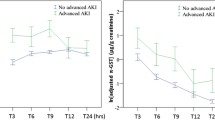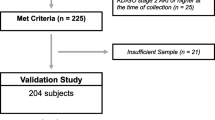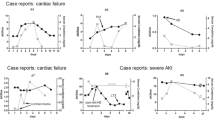Abstract
Objective: Cardiac surgery is an important risk factor for the development of acute renal failure. Cytosolic enzymes glutathione S-transferase (GST) A1 and P1 are present selectively in proximal and distal tubular cells, respectively. We determined the extent and site of tubular injury and examined if GST excretion may predict a clinically relevant change in renal function. Design and setting: A prospective, observational study in 84 consecutive patients in the cardiac surgery intensive care unit of the University Medical Centre Nijmegen. Measurements and results: Urinary GST enzyme excretion was determined 0–4 h and 20–24 h after cardiac surgery by enzyme-linked immunosorbent assay. Data are expressed as median and 5–95% range. Urinary excretion of GSTA1 was increased: 1.25 μg/mmol [0.31–10.20] creatinine at t =0–4 h ( p <0.0001, compared with controls; 0.25 [0.1–0.8]) and returned to normal values at t =20–24 h. Excretion of GSTP1 was 2.11 μg/mmol [0.52–17.82] creatinine ( p <0.0001) at t =0–4 h and remained significantly elevated: 0.84 [0.30–16.86] at t =20–24 h ( p =0.01) compared with controls (0.5 [0.2–1.1]). The ten patients with the highest urinary excretion of GSTA1 or GSTP1 did not demonstrate a different plasma creatinine level on postoperative day 3, compared with the ten patients with the lowest urinary excretion of GSTA1 or GSTP1. Conclusion : Uncomplicated cardiac surgery results in a statistically significant increase in the urinary excretion of GSTA1 and GSTP1 as compared with healthy controls, indicating proximal and distal tubular damage. However, this small increase in urinary excretion of GSTs is not associated with clinically relevant renal injury.


Similar content being viewed by others
References
Bouman C, Kellum JA, Lameire N, Levin N (2004) Acute dialysis quality initiative. Definitions of acute renal failure. http://www.anes.upmc.edu/mcctp/adqi02.html
Chertow GM, Levy EM, Hammermeister KE, Grover F, Daley J (1998) Independent association between acute renal failure and mortality following cardiac surgery. Am J Med 104:343–348
Block CA, Manning HL (2002) Prevention of acute renal failure in the critically ill. Am J Respir Crit Care Med 165:320–324
Chertow GM, Lazarus JM, Christiansen CL, Cook EF, Hammermeister KE, Grover F, Daley J (1997) Preoperative renal risk stratification. Circulation 95:878–884
Hamada Y, Kanda T, Anzai T, Kobayashi I, Morishita Y (1999) N-acetyl-beta-D-glucosaminidase is not a predictor, but an indicator of kidney injury in patients with cardiac surgery. J Med 30:329–336
Mannervik B, Alin P, Guthenberg C, Jensson H, Tahir MK, Warholm M, Jornvall H (1985) Identification of three classes of cytosolic glutathione transferase common to several mammalian species: correlation between structural data and enzymatic properties. Proc Natl Acad Sci U S A 82:7202–7206
Harrison DJ, Kharbanda R, Cunningham DS, McLellan LI, Hayes JD (1989) Distribution of glutathione S-transferase isoenzymes in human kidney: basis for possible markers of renal injury. J Clin Pathol 42:624–628
Westhuyzen J, Endre ZH, Reece G, Reith DM, Saltissi D, Morgan TJ (2003) Measurement of tubular enzymuria facilitates early detection of acute renal impairment in the intensive care unit. Nephrol Dial Transplant 18:543–551
Piper SN, Kumle B, Maleck WH, Kiessling AH, Lehmann A, Rohm KD, Suttner SW, Boldt J (2003) Diltiazem may preserve renal tubular integrity after cardiac surgery. Can J Anaesth 50:285–292
Boldt J, Brenner T, Lehmann A, Lang J, Kumle B, Werling C (2003) Influence of two different volume replacement regimens on renal function in elderly patients undergoing cardiac surgery: comparison of a new starch preparation with gelatin. Intensive Care Med 29:763–769
Mulder TP, Peters WH, Court DA, Jansen JB (1996) Sandwich ELISA for glutathione S-transferase Alpha 1–1: plasma concentrations in controls and in patients with gastrointestinal disorders. Clin Chem 42:416–419
Mulder TP, Peters WH, Wobbes T, Witteman BJ, Jansen JB (1997) Measurement of glutathione S-transferase P1–1 in plasma: pitfalls and significance of screening and follow-up of patients with gastrointestinal carcinoma. Cancer 80:873–880
Branten AJ, Mulder TP, Peters WH, Assmann KJ, Wetzels JF (2000) Urinary excretion of glutathione S transferases alpha and pi in patients with proteinuria: reflection of the site of tubular injury. Nephron 85:120–126
Sarvary E, Nemes B, Jaray J, Dinya E, Borka P, Varga M, Sulyok B, Remport A, Toth A, Perner F (2000) Prediction of early renal graft function by the measurement of donor urinary glutathione S-transferases. Transplantation 69:1397–1402
Cressey G, Roberts DR, Snowden CP (2002) Renal tubular injury after infrarenal aortic aneurysm repair. J Cardiothorac Vasc Anesth 16:290–293
Acknowledgements
We thank Hennie Roelofs for excellent determination of GST concentrations and our research nurses and the nurses of the cardiac surgery ICU for their help in collecting urine and blood samples
Author information
Authors and Affiliations
Corresponding author
Additional information
P. Pickkers is a recipient of a Clinical Fellowship grant of the Netherlands Organisation for Scientific Research (ZonMw). J.J.A.E. and L.T.G.J.v.E. equally contributed to the writing of this paper
Rights and permissions
About this article
Cite this article
Eijkenboom, J.J.A., van Eijk, L.T.G.J., Pickkers, P. et al. Small increases in the urinary excretion of glutathione S-transferase A1 and P1 after cardiac surgery are not associated with clinically relevant renal injury. Intensive Care Med 31, 664–667 (2005). https://doi.org/10.1007/s00134-005-2608-2
Received:
Accepted:
Published:
Issue Date:
DOI: https://doi.org/10.1007/s00134-005-2608-2




